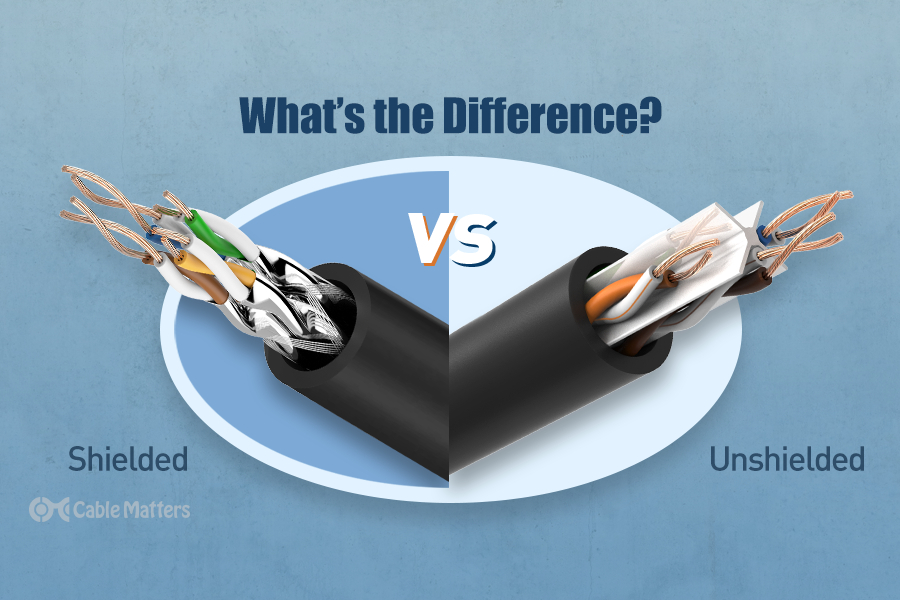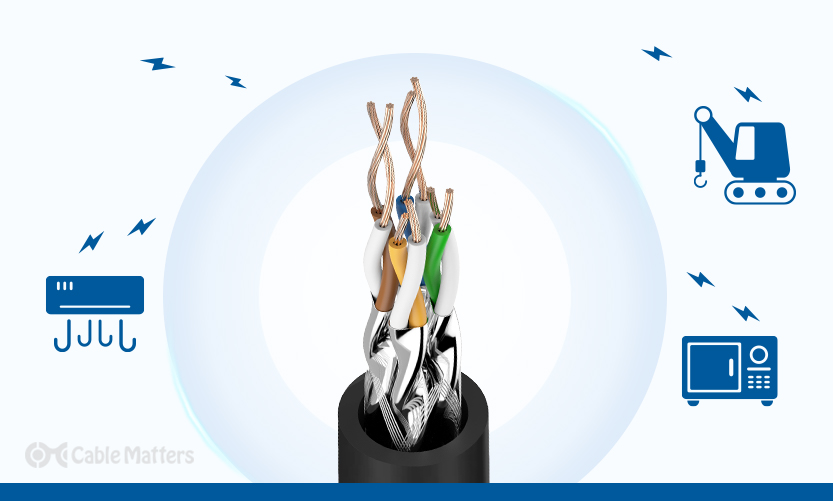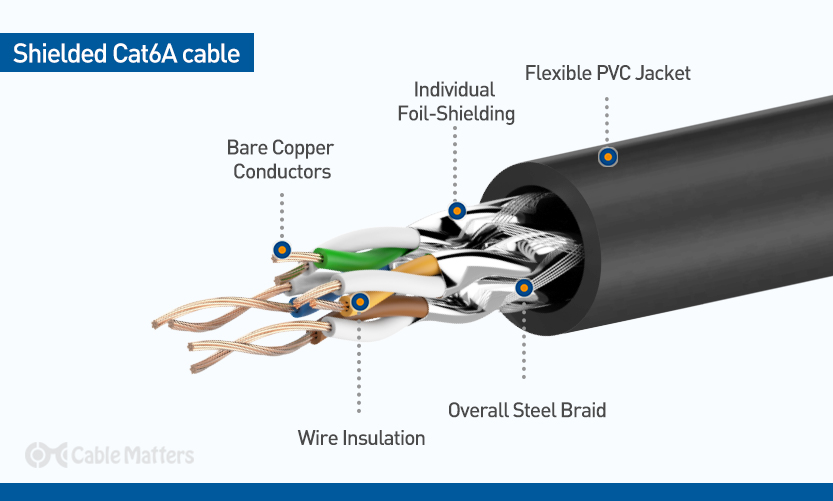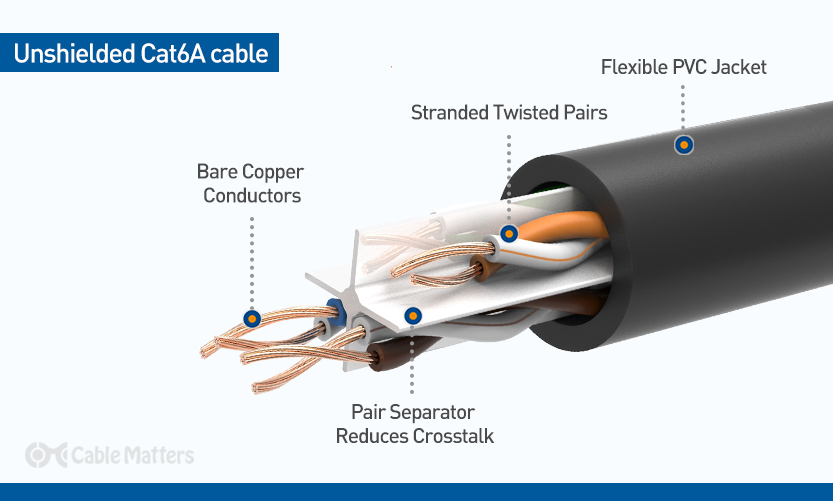
All Ethernet cables have some measure of shielding against electromagnetic interference (EMI), but some cables have much more robust protections in place. Specifically, some of these cables are granted the “Shielded” designation, whilst others are considered “Unshielded.” When it comes to you picking the right Ethernet cable for your networking needs, the shielded vs. unshielded debate is an important one to settle.
Should you buy the more expensive, but more EMI-protective shielded cables, or the more affordable unshielded cables with weaker EMI protections? What about choosing between different types of shielding? It can be a tricky decision to make, but once you’ve considered your particular cabling and networking needs, you should find it relatively straightforward to decide the winner of shielded vs. unshielded cables.
What are Shielded Cables?
Shielded twisted pair cables (STP) are Ethernet cables that feature additional protection against electromagnetic interference. That can be anything from heaps of unshielded wires bunched together, to the air conditioning unit running next to your cabling, to the leaky microwave in the office kitchen near your network. That presents a problem when it comes to transmitting important data, as EMI has the potential to disrupt it.

Whatever the source of the EMI, though, STP cables are designed to protect against it far better than unshielded cables. They achieve that through various methods of construction which provide better levels of protection. At the core of the cabling, all unshielded and shielded cables are built with twisted pairs of copper wiring. Those pairs are twinned deliberately to reduce crosstalk between them and the other pairs, but shielded cables go much further than that.
Shielded cables can have shielding for each of the twisted pairs individually, shielding for all of the cables together, or both. Typically this comes in the form of foil or braided shielding, and there are lettered designations for each type.
- F/UTP: A shielded cable with a foil shield around the entire cable, with unshielded twisted pairs inside. These offer the most basic level of shielding against EMI, and the foil shield can be prone to damage over time due to the fragility of the shielding material.
- S/UTP: A shielded cable that uses a braid, or screen, around the entire cable. This doesn’t provide as much protection as foil shielding, but it is more durable. It’s also more traditional, and quite commonly found in older shielding cables. It can add considerable extra weight to the cable, though, which can make managing it a little more complicated.
- SF/UTP: A shielded cable that has a braided shield around a foil shield, both of which protect the cable as a whole, while the individual twisted pairs are still unshielded. This is an effective combination of shielding for external EMI, which does less to protect against crosstalk between the internal wires.
- F/FTP: A shielded cable with a foil shield around the entire cable, and foil shielding around each twisted pair. This provides effectively 100% shielding against EMI, but the foil is vulnerable to physical damage over time.
- S/FTP: A shielded cable with a braided shield around the entire cable, and foil shielding around each twisted pair. This is the most common form of shielded cable because it provides nearly 100% protection while remaining strong and flexible.
- SF/FTP: A shielded cable with both a braided shield and foil shield around the cable, with foil shielding around the individual twisted pairs. This is the highest level of Ethernet shielding available, with strong external EMI protections, warding against crosstalk, and a durable braided shield to help prevent future damage to the shielding.
Some shielded cables also include an internal spline or a plastic divider within the cable which separates the twisted pairs from one another to further mitigate against crosstalk between them. These can also be present in some unshielded cables, as it also provides additional rigidity to the cable as a whole.
What are Unshielded Cables?
Unshielded cables are a lot more straightforward than their shielded counterparts. Often called UTP (Unshielded Twisted Pair) these cables offer the same bandwidth, cable lengths, and outputs as shielded cables, but don’t feature the EMI protections of their shielded cousins.
Although some UTP ethernet cables will have splines for improved rigidity, and some minor EMI protection, they are, for the most part, unprotected against heavy exterior interference. That lack of shielding does have some benefits, though. UTP cables are usually cheaper than the shielded alternatives, and they tend to be thinner and lighter, which can make installation a bit easier.
Shielded vs. Unshielded Ethernet Cables
It might seem that shielded cables are probably the best way to go, especially if data integrity is incredibly important to your network. And to some extent, that’s true, but there are some other factors worth considering that could make your choice of shielded vs. unshielded cables a little harder to make.
Shielded cables do indeed offer much greater protection against EMI – close to 100% for the most heavily shielded cables. That all but guarantees data integrity, resulting in fewer visual hiccups in video streams, and more reliable data transfers across the network. However, all of that shielding has its drawbacks, namely in cost, and physical changes to the cable.
Shielded cables are more expensive than their unshielded counterparts. Shielded cables with the greatest protections – combining braiding and individual foil shielding for the twisted pairs – are the most expensive of all. It doesn’t add up to much on individual cables, but for entire networks that cost can add up. Shielded cables are also thicker and heavier, which can make installation more difficult, especially since the cables are more rigid, making it harder to run them through tight spaces, or around corners.
The cost problem is compounded by requiring additional shielded hardware at the ends of the cables to fully protect against EMI, and some networks will require additional grounding wires to provide full protection.
Unshielded cables, on the other hand, don’t have any of that. They’re more affordable, are easier to install, and are much lighter to work with. That makes them easier to carry around, and in extreme bulk, makes them cheaper to ship between locations, too.
They don’t, however, provide much in the way of EMI protection. Even so, unshielded cables are the most widely used cable type and have been for many years, so many existing networks all over the world are built using unshielded cables. If you are expanding any of those networks, it may not be worth using shielded cables, since the existing network infrastructure will be a weak point in your network protections.
This should make the shielded vs. unshielded cables debate an easy one to solve. If you need EMI protections, you’re going to need shielded cables. However, if you can get away with it, you’ll save money, and installation headaches by going with unshielded cables instead.


Which Cable Should You Use?
The choice of shielded vs. unshielded cables is at least relatively straightforward: if you are concerned about the sanctity of your data on your network, get shielded cables. If your network is in a busy location with lots of other electronic devices, particularly heavy machinery and air conditioning units, then get shielded cables. If aren’t sure whether you need shielded cables or not, just play it safe and get shielded cables.
For everything else, unshielded should be perfectly fine. Just be sure that even if you’re buying unshielded cables, you buy ones that are built to a high standard. That is cables with a solid copper core, not copper-clad aluminum, and if you want some additional rigidity in the cable (and some protection against crosstalk) get one with a spline too.
But if you’re picking shielded cabling, how do you know which shielded cable to pick? That isn’t quite as tricky as it might seem. If you want a high grade of protection there are Cable Matters Cat6A cables which feature foil protections for the twisted pairs, and an outer braiding for the cable. It’s also available in bulk reels of 1,000ft of shielded Cat6A cabling if you’re interested in building your own shielded cables.
For the ultimate in shielded cabling, however, you should consider the latest and greatest Ethernet cable technology: Cat8 cables. These offer the highest network performance, managing up to 40 Gbps over 100ft, or up to 10Gbps over 300ft. Unlike other categories of cables, however, they are mandated to come with foil wrappings on the individual twisted pairs, so you’re guaranteed to get a high-quality shielded cable with a Cat8 cable from Cable Matters. Alongside that foil wrapping, they also include braided shielding. That does raise costs slightly, but not significantly so.
If you want to build your own highly-shielded Cat8 Ethernet cables, be sure to combine them with shielded RJ45 termination plugs, and if you’re planning to plug them into a patch panel, you want to ensure you’re using shielded Cat8 keystone jacks, too. Just be sure to wire it correctly: here’s a breakdown of everything you need to get started managing your patch panels, cabinets, and Ethernet connections.
If you’re looking to build a network with much longer distance cabling, consider checking out our guide to fiber optic cables and all the intricacies that come with building a network over hundreds, or even thousands of meters.